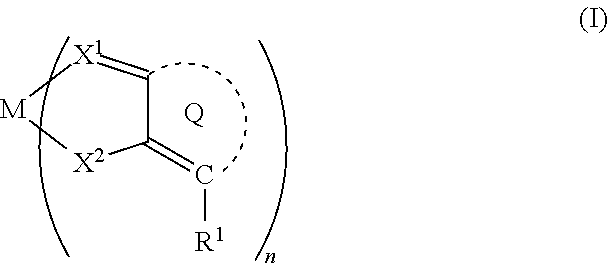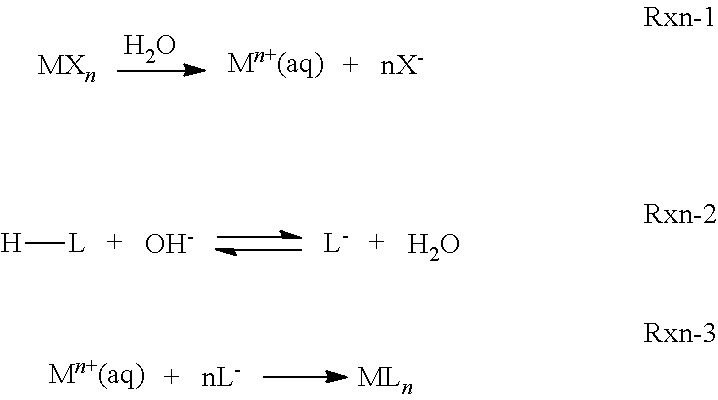Aqueous inkjet printing fluid compositions
a technology of inkjet printing and compositions, applied in the field of aqueous compositions, can solve the problems of inability to meet the needs of printing head etching, and increased dissolution rate, so as to improve the stability of inkjet printing fluid compositions, reduce etching, and reduce the effect of etching
- Summary
- Abstract
- Description
- Claims
- Application Information
AI Technical Summary
Benefits of technology
Problems solved by technology
Method used
Image
Examples
example 1
Glass Etching by Continuous Inkjet Ink Samples
[0104]In this example, the corrosion of borophosphosilicate (BPSG) glass by the series of Inks A-L has been evaluated. These experiments provide a means of assessing the corrosion inhibition towards a silicon oxide glass produced by the aluminum salt and coordination complex compositions. For the BPSG etching experiments, coupons (1 cm2) of BPSG (600 nm) coated on silicon (0.7 mm Si(100)) were immersed in Inks A-L in sealed containers. The BPSG coating thicknesses were measured before and after incubation in the ink at 80° C. at various time intervals. The BPSG coating thickness was determined by spectroscopic ellipsometry, using an α-SE Spectroscopic Ellipsometer obtained from J. A. Woollam and Co., Inc. Computer algorithms were used to interpret the measured ellipsometric data in terms of an appropriate coating structure and coating thickness. Detailed treatments of computer algorithms for fitting ellipsometric data have been provided ...
example 2
Solution Acidity and Stability of Aluminum Compounds
[0107]In this example, the Model inks B L and the standard aqueous solutions of aluminum compounds of the type known in the art and of the type disclosed in this invention are evaluated. In inkjet systems, increases in acidity can be undesirable, especially in alkaline formulations, where the resulting decreases in pH value can cause aggregation of particles and precipitation of inkjet ink components such as oligomers and polymers, dispersed pigment particles, soluble colorant dyes, surfactants, etc. Moreover, precipitation of metal salts, like aluminum salts, can be undesirable, because printhead die fouling can occur, producing crooked jets or blocked jets for example. The data presented in Table III show that inorganic aluminum salts of the type known in the art (entries 1 and 2) are ionized in water, which results in significant ionic conductivity increases over the 18 Mohm water solvent, which will have a base conductivity of ...
example 3
Effect of Solution pH on Inkjet Polymer P1
[0110]This example shows how acidity affects a polymer designed for use in alkaline inkjet formulations. In this experiment, formulations containing 1.8 w / w % of the Inkjet Polymer P1 in phosphate buffers (0.1 M) were prepared and monitored visually. Formation of agglomerates or precipitates was indicated by solution turbidity. The data in presented in Table IV clearly demonstrate that pH value significantly influences the stability of formulations containing polymeric dispersants like Inkjet Polymer P1, even in the absence of free multivalent metal ions like aluminum (III). Even in mildly acidic solutions (entry 2) and evidently in more acidic solutions (entry 1), the polymer is readily observed to form agglomerates and / or precipitates as indicated by the solution turbidity. By contrast in near neutral (entry 3) to alkaline (entry 4) solutions, the polymer remains dispersed or dissolved in solution, as indicated by the solution clarity.
[011...
PUM
| Property | Measurement | Unit |
|---|---|---|
| weight percent | aaaaa | aaaaa |
| pressures | aaaaa | aaaaa |
| pressures | aaaaa | aaaaa |
Abstract
Description
Claims
Application Information
 Login to View More
Login to View More - R&D
- Intellectual Property
- Life Sciences
- Materials
- Tech Scout
- Unparalleled Data Quality
- Higher Quality Content
- 60% Fewer Hallucinations
Browse by: Latest US Patents, China's latest patents, Technical Efficacy Thesaurus, Application Domain, Technology Topic, Popular Technical Reports.
© 2025 PatSnap. All rights reserved.Legal|Privacy policy|Modern Slavery Act Transparency Statement|Sitemap|About US| Contact US: help@patsnap.com



